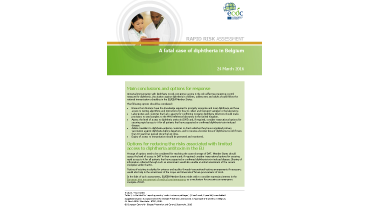Rapid risk assessment: Cutaneous diphtheria among recently arrived refugees and asylum-seekers in the EU, 31 July 2015
Three countries (Denmark, Germany and Sweden) have reported seven cases of toxigenic cutaneous diphtheria and two cases of non-toxigenic cutaneous diphtheria among refugees in 2015. Meanwhile, 13 other EU Member States have reported that they have no notifications of any such cases. This rapid risk assessment concludes that there is currently no indication that these cases represent a significant outbreak of diphtheria among refugees in Europe.
Executive Summary
A total of nine cases of cutaneous diphtheria among refugees and asylum-seekers have been notified by Denmark, Sweden and Germany in 2015. According to ECDC's rapid risk assessment, there is no indication that these cases represent a significant outbreak of diphtheria among refugees in Europe.
However, health systems might not be able to detect cutaneous diphtheria outbreaks among refugees because refugees have limited access to health services.
Travellers to diphtheria-endemic countries should check their vaccination status before departure and get a booster dose if their last diphtheria vaccination was more than 10 years ago. Refugees who lack evidence of vaccination against diphtheria should be considered as unprotected and be provided with the appropriate vaccination in accordance with national immunisation guidelines.
European travellers may get infected and develop a cutaneous diphtheria while travelling or working in endemic countries. ECDC data show that most of the travellers who were diagnosed with cutaneous diphtheria on their return had not received booster vaccinations or had unknown vaccination status.
Download







